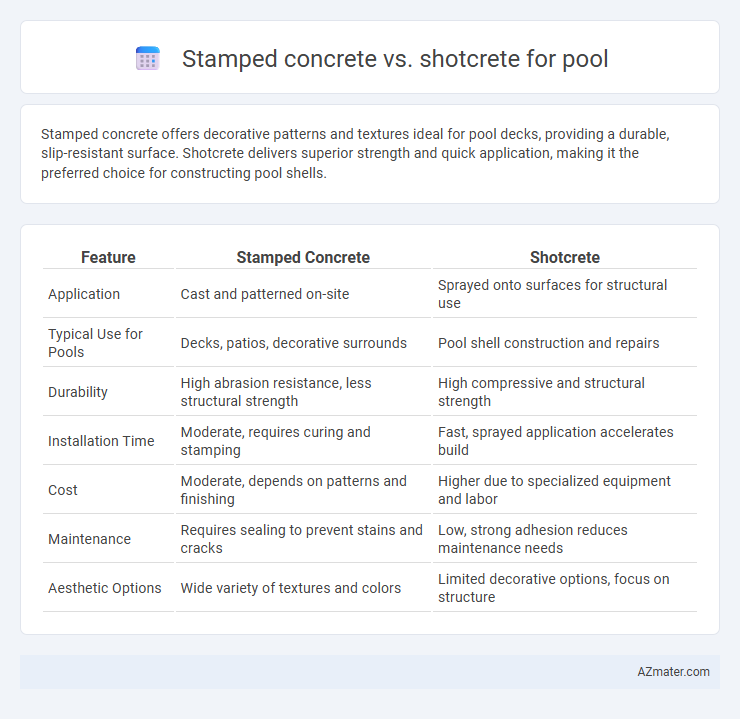Stamped concrete offers decorative patterns and textures ideal for pool decks, providing a durable, slip-resistant surface. Shotcrete delivers superior strength and quick application, making it the preferred choice for constructing pool shells.
Table of Comparison
| Feature | Stamped Concrete | Shotcrete |
|---|---|---|
| Application | Cast and patterned on-site | Sprayed onto surfaces for structural use |
| Typical Use for Pools | Decks, patios, decorative surrounds | Pool shell construction and repairs |
| Durability | High abrasion resistance, less structural strength | High compressive and structural strength |
| Installation Time | Moderate, requires curing and stamping | Fast, sprayed application accelerates build |
| Cost | Moderate, depends on patterns and finishing | Higher due to specialized equipment and labor |
| Maintenance | Requires sealing to prevent stains and cracks | Low, strong adhesion reduces maintenance needs |
| Aesthetic Options | Wide variety of textures and colors | Limited decorative options, focus on structure |
Introduction to Stamped Concrete and Shotcrete for Pools
Stamped concrete is a decorative concrete technique that mimics natural materials like stone or brick, offering customizable patterns and colors ideal for pool decks and surrounding areas. Shotcrete involves spraying concrete onto surfaces at high velocity, providing strong structural integrity and excellent bonding, commonly used for shaping pool shells and complex contours. Both methods enhance pool aesthetics and durability, with stamped concrete emphasizing design versatility and shotcrete focusing on structural strength.
What is Stamped Concrete?
Stamped concrete is a decorative technique where concrete is poured and then imprinted with patterns and textures to mimic natural materials such as stone, brick, or tile, making it a popular choice for pool decks due to its aesthetic appeal and slip resistance. This method involves adding color and using specialized stamps to create intricate designs that enhance the pool area's visual appeal while providing durability and low maintenance. Stamped concrete is valued for its ability to combine functionality with style, offering a customized look that complements various pool designs.
What is Shotcrete?
Shotcrete is a high-strength concrete mixture sprayed onto surfaces at high velocity, ideal for constructing pool shells due to its excellent adhesion and structural integrity. Unlike stamped concrete, which is poured and then textured, shotcrete uses a pneumatic application that allows for more complex shapes and faster curing times. This method provides a durable, waterproof barrier that enhances pool longevity and reduces maintenance needs.
Installation Process Comparison
Stamped concrete installation for pools involves pouring a concrete slab followed by imprinting patterns and textures while the surface is still pliable, requiring skilled labor to achieve the desired aesthetic and durability. Shotcrete application uses a high-pressure hose to spray concrete onto pool surfaces, allowing for faster setup and adaptability to complex shapes with minimal formwork. Both methods demand proper curing and finishing techniques, but shotcrete typically offers quicker installation timelines and enhanced structural bonding compared to stamped concrete.
Durability and Longevity
Stamped concrete and shotcrete both offer durable options for pool construction, but shotcrete generally provides superior strength and longevity due to its high compressive strength and dense matrix. Shotcrete's method of application ensures fewer voids and better adhesion, resulting in enhanced resistance to cracking and weathering compared to stamped concrete. While stamped concrete delivers aesthetic versatility with textured finishes, it requires more maintenance to prevent surface wear and potential deterioration over time around pool areas.
Design and Aesthetic Options
Stamped concrete offers intricate patterns and textures that mimic natural stone, brick, or wood, providing extensive customization for pool decks and surrounding areas. Shotcrete allows for fluid, sculpted forms that are ideal for creating unique, organic shapes and seamless surfaces in pool construction. Both methods support a variety of finishes and colors, but stamped concrete excels in decorative detail while shotcrete enables innovative, three-dimensional design elements.
Maintenance Requirements
Stamped concrete for pools requires regular sealing every 2-3 years to protect against water damage and prevent color fading, along with routine cleaning to avoid mold and algae buildup. Shotcrete, known for its dense and durable composition, demands less frequent maintenance but should still be inspected annually for cracks and resurfaced as needed to maintain waterproofing. Both materials benefit from proper drainage systems to reduce wear and extend the lifespan of the pool structure.
Cost Analysis: Stamped Concrete vs Shotcrete
Stamped concrete typically costs between $8 to $16 per square foot, making it a budget-friendly option for pool decks with customizable patterns and textures. Shotcrete, priced around $10 to $15 per square foot, offers superior durability and faster application time, potentially lowering labor expenses. The overall cost depends on factors like pool size, complexity, and finish quality, with shotcrete often favored for structural strength despite slightly higher initial investment.
Pros and Cons of Each Method
Stamped concrete offers aesthetic versatility with customizable patterns and colors, making pools visually appealing while providing a durable and slip-resistant surface. However, it can be prone to cracking over time and may require regular sealing to maintain its appearance and protect against water damage. Shotcrete provides superior structural strength and flexibility for complex pool shapes, offering faster application and reduced labor costs, but it typically requires additional finishing work and may have a rougher texture that needs smoothing for comfort.
Choosing the Best Option for Your Pool Project
Stamped concrete offers customizable patterns and textures, providing aesthetic appeal ideal for pool decks and patios, while shotcrete delivers superior strength and durability through its pneumatically applied concrete. For pool projects requiring complex shapes and enhanced structural integrity, shotcrete is often preferred due to its ability to adhere well to varied surfaces and reduce crack risks. Prioritize factors such as design complexity, budget constraints, and long-term maintenance when choosing between stamped concrete and shotcrete for optimal pool construction results.

Infographic: Stamped concrete vs Shotcrete for Pool
 azmater.com
azmater.com